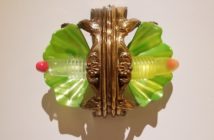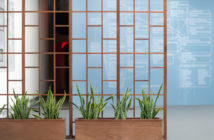
I stood next to a Sandback sculpture during the Dance/ Draw exhibit at the ICA Boston last year. I remember it vividly. I was there to protect it physically (and conceptually, in my mind). It was a bit different from the ones above, made of three primary colored strands of yarn that framed this big space, an entire wall. Together they are a painting rather than a sculpture. Red and yellow play against the light of the museum wall, tripping up and down the thin yarn-wire. And slam—the yellow disappears into the floor. The red hits the floor and turns, abruptly, to the left. It is unbelievably bright and straight against Diller and Scofidio’s warm grey floor. It is a drawing, this perfect line. Suddenly, it drops back into the floor without drama, simply ending. A pause and then the weight is picked up after a dash of empty grey by a vertical blue line taking off to the ceiling again. Straight up, a shot recorded and manifested in a tense blue line. I cannot for the life of me find an image of this particular piece from my memory, so your imaginations will have to do.
As an art form, drawing sometimes seems to be painting’s silly little sister. It is often a preparation for a larger piece. It is observation, it is experimentation, it is the direct imprint of the hand. There is an informality to it. Sandback draws, but not in that sense. He draws as an architect draws. And this is not because his lines are straight (an architect’s lines are often not straight almost until they are walls). He draws to define space, to affect your world and to heighten your sense of your environment. He uses line to create new spaces.
For me, Sandback’s work is about this other side of drawing. Lines with purpose and without sentiment. They will enter your world in a slippery way — they are just bits of yarn, after all. But then they stand bold, tall and defiant against the empty white room — a statement of presence and absence, imagination and possibility.
•••
Image Information: Fred Sandback, Untitled (Sculptural Study for Room with Three Entrances), 1981/2011
Black acrylic yarn, dimensions variable



